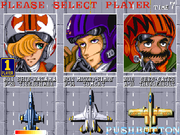This is an old revision of this page, as edited by Deltasim (talk | contribs) at 13:53, 23 January 2013 (Removed excessive details). The present address (URL) is a permanent link to this revision, which may differ significantly from the current revision.
Revision as of 13:53, 23 January 2013 by Deltasim (talk | contribs) (Removed excessive details)(diff) ← Previous revision | Latest revision (diff) | Newer revision → (diff)| This article needs additional citations for verification. Please help improve this article by adding citations to reliable sources. Unsourced material may be challenged and removed. Find sources: "U.N. Squadron" – news · newspapers · books · scholar · JSTOR (April 2009) (Learn how and when to remove this message) |
| U.N. Squadron | |
|---|---|
 Sales flyer for the arcade version. Sales flyer for the arcade version. | |
| Developer(s) | Capcom |
| Publisher(s) | Capcom |
| Composer(s) | Manami Matsumae Takashi Tateishi Mari Yamaguchi |
| Platform(s) | Arcade, Amiga, Amstrad CPC, Atari ST, Commodore 64, SNES, ZX Spectrum |
| Release | August Template:Vgy SNES |
| Genre(s) | Scrolling shooter |
| Mode(s) | Up to 2 players, cooperative |
| Arcade system | CPS-1 |
U.N. Squadron is a Template:Vgy side scrolling shooting game released for the CPS arcade hardware by Capcom. The game was released in Japan as Area 88 (Japanese: エリア88, Hepburn: Eria Hachi-Jū-Hachi) and is based on the manga series of the same name, featuring the same main characters. Here, their mission is to stop a terrorist group known as Project 4. It was followed by the sequel Carrier Air Wing.
Gameplay

The game is a typical side scrolling shooter, going against the trend of other Capcom shooters, such as 1942, and 1943: The Battle of Midway, which are vertically scrolling shooters. However, like other Capcom shooters, the player has a life / energy bar that is consumed over the course of a single life as the player sustains damage, a trait highly uncommon among other comparable arcade-style shooters which normally use a system of reserve lives, where one of which is lost upon a single enemy hit. Before entering a level, the player has the opportunity to purchase special weapons or added defenses in the shop. The player earns money to buy weapons by destroying enemy planes and vehicles during levels and, when the level is finished, any unused weapons are converted back into money.
The player can choose between three mercenary pilots: Shin Kazama, Mickey Simon, and Greg Gates. Each pilot flies a specific plane and has slightly different capabilities.
Pilots
- Shin Kazama: Shin flies an F-20 Tigershark; the weapons on his plane fire forward only but at a quick pace. Shin and his plane are the most balanced combination available.
- Mickey Simon: Mickey flies an F-14 Tomcat; the weapons on his plane also fire forward only, but are also larger (albeit slower), inflicting more damage than Shins plane.
- Greg Gates: Greg flies an A-10 Thunderbolt; this plane has smaller forward fire than either Shin or Mickey's planes, but it also fires a second stream downward at a 45° angle from the forward firing stream.
Reception
IGN ranked U.N. Squadron 37th on their "Top 100 Super Nintendo Games" list, which made U.N. Squadron the highest ranking side scroller shooter game on that list.
References
- "Super NES Games" (PDF). Nintendo. Retrieved 2012-07-25.
- http://www.ign.com/top/snes-games/37
External links
- U.N. Squadron at Arcade-History
- Area 88 at the Killer List of Videogames
- U.N. Squadron at MobyGames
- U.N. Squadron at the Killer List of Videogames
- Template:GameFAQs
- UN Squadron SNES review from Mean Machines Archive
- Area 88 review at the Anime Super Famciom Web Resource Center
| Area 88 by Kaoru Shintani | |
|---|---|